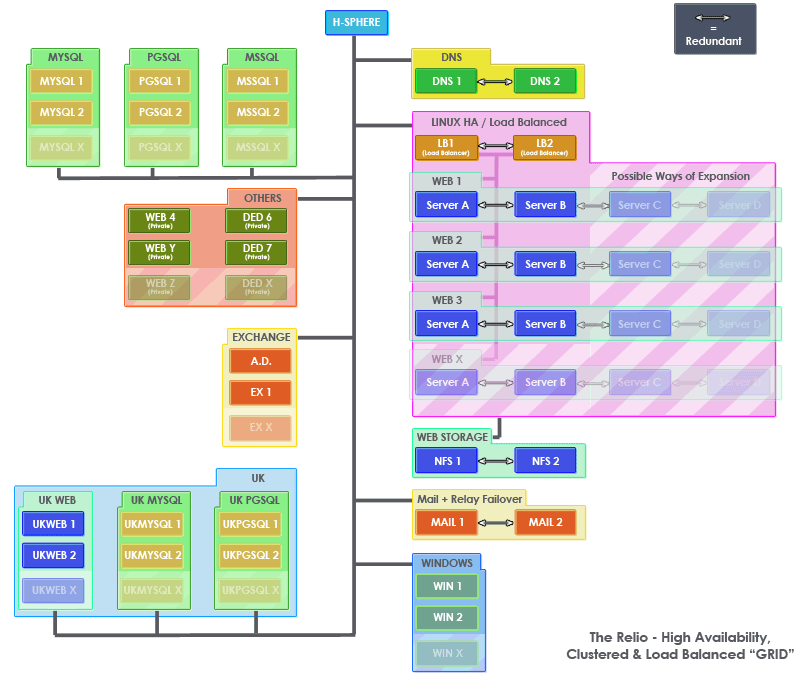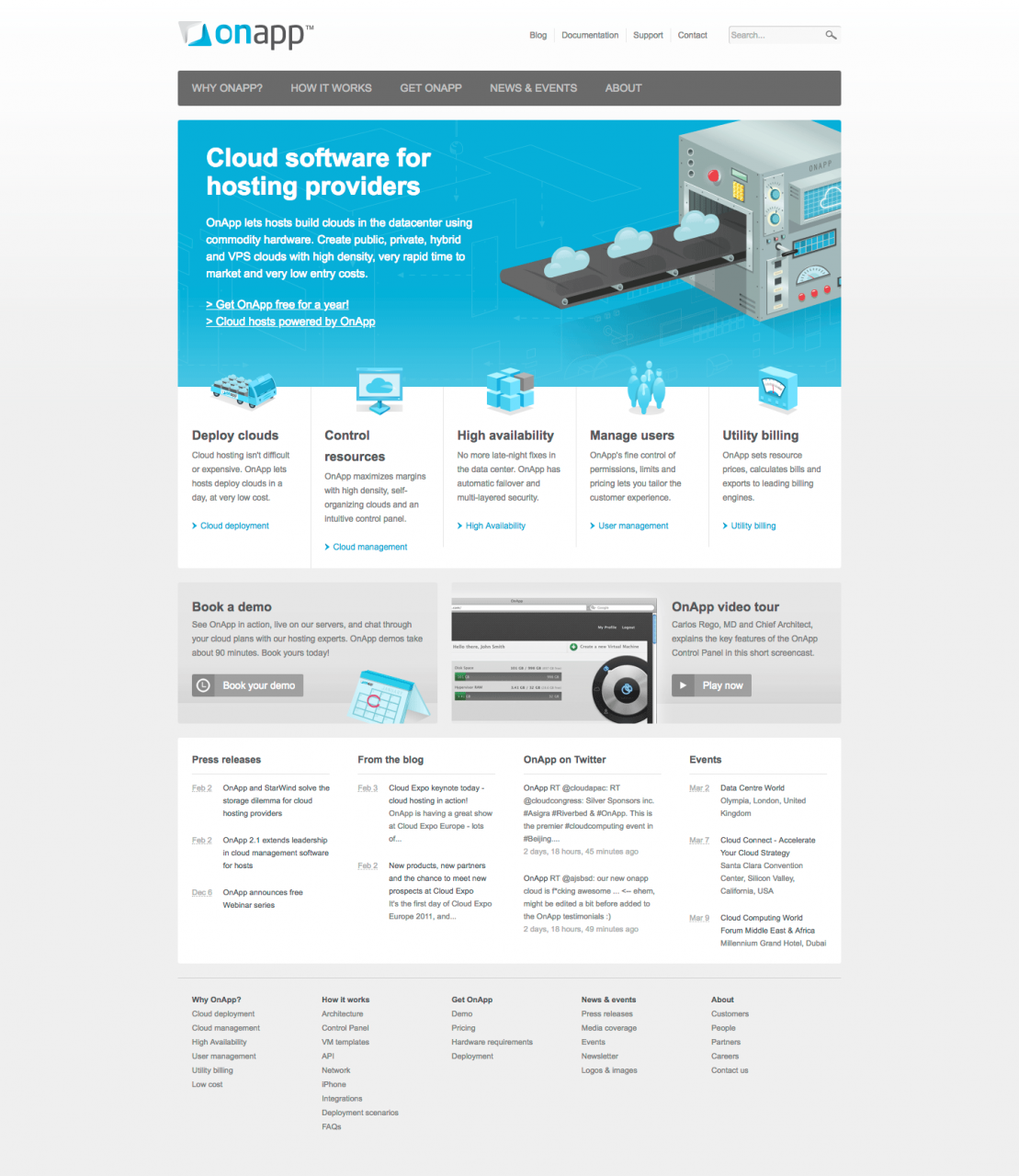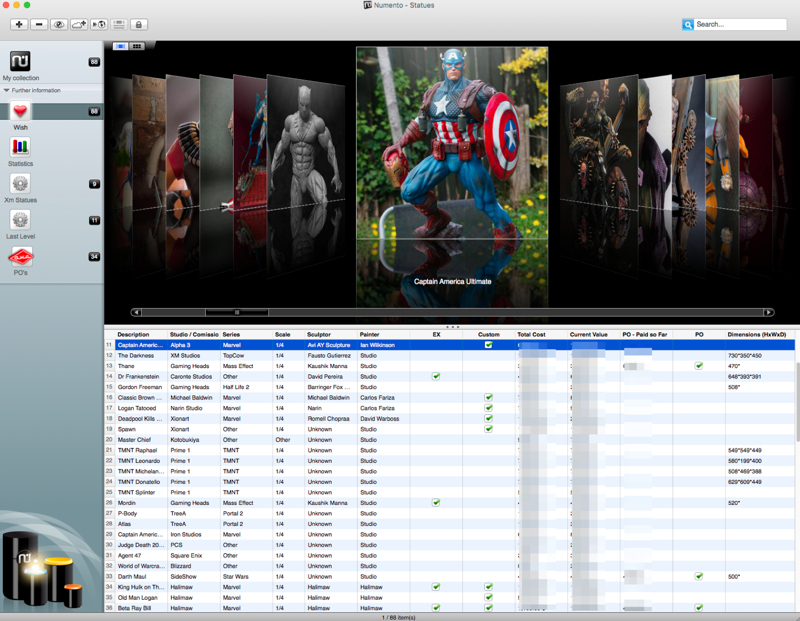Ok, I say going HA/LB/GRID .. because depending on who you ask, you get the setup we deploying named after one of them.
I gave the guys the green light yesterday to go ahead and setup the load balancers, NFS and redundant servers for the Linux setup, we expect to have it al done, and tested in as little as 4 weeks, but it can be as much as 8.
This is a sketch on how the network will look (not all servers are listed, but gives a good idea)

High Availability doesn’t come cheap, but looks pretty 🙂
I am now in talks with the 3TERA folks about using Applogic with H-Sphere (as a PSoft executive, for PSoft clients and their H-Sphere setups), and I am VERY excited about it, and I believe it’s a terrific solution that our clients will love, but I wont be using it for Relio, for several reasons, none of them is me not trusting the technology, au contraire, I think it’s great, but mainly, I need to deploy this NOW .. and we still have a long road ahead before H-Sphere and Applogic and speaking to each other, second, for OUR kind of setup, I see a little bit of resource wasting with Applogic…
3TERA’s solution uses VPS’s for servers (nodes), it’s nice, and they can be deployed rather quickly .. but for Relio I see it as a waste of resources, if I put 10 VPS’s on 1 server, each VPS will consume allot of OS related resources, so I get less output from that server.
Instead what we doing is doing proper load balancing for HA .. by making each node a actual physical server .. now the downgrade is that it takes more time to deploy a hardware server, so if you are in the business of providing instant growth potential to clients, it’s slower than VPS (I can deploy a vps in minutes, a server .. 1 hour, if it’s in stock).
But thats not the market we are after, we instead wish to provide High Availability / Reliability .. so, as such, each server will have at least 2 nodes running at all times, if one goes down, the other is still alive and taking requests, this also allows for a sideways growth, were instead of deploying . say WEB10 .. you deploy another node on WEB9 .. so now WEB9 has 3 servers running, it can take allot more traffic.
Also, all the web data does not reside on the webservers, but on the NFS system instead, so when any of them goes down, the data itself is unaffected.
Our intention is to have each server (WEB) run on 3-4 nodes .. so if any of them breaks .. there are 2 or 3 left to take the load .. then you dont mind if it takes 1 hour to bring the problem node back up.
Also, another nice thing with the 3TERA solution, is the fact that it’s also easier to move your whole infrastructure to another provider if you need to do so in a harry, we are literally our own providers, so that also does not apply.
Back on our setup…, this also opens up another possibility, later when we have load balancing for Windows, if we make the data all reside on the NFS systems, we can focus in having single accounts for Linux and Windows .. each deployed domain would simply be assigned to one platform or the other.
I’m not sure yet how windows plays (if any) with NFS .. so more discussions on that will be needed with the dev team, but if I could have a single FTP to load up both my windows and linux domains .. that would be heaven 🙂
Technorati Tags: GRID, H-Sphere, HA, HSPhere, Linux, Load Balancing, Relio, WebHosting




How to Load Balance a Web Site on Multiple Geographic Datacenters… Cheaply!
This article explains how to geographically distribute a web site for $100 or less per month,
including web hosting, geo-ip services, and DNS services.
“but for Relio I see it as a waste of resources, if I put 10 VPS’s on 1 server, each VPS will consume allot of OS related resources, so I get less output from that server.”
That’s not necessarily always true. Ok, so there will be some overhead, but if you use Virtuozzo you’ll be able to use VZ templates and only have one instance of an application in memory and on disk for unlimited VPS’s using the same binary. If you modify it on a per-VPS basis this won’t be the case, but if you leave unmodified versions within each VPS and only update them via templates, you’ll not lose out that much really, just a few percent of resources. I suspect you’ll rarely modify within the VPS too, as a major benefit is the ability to roll out updates using templates much quicker across multiple VPS’s than making individual changes within each VPS.
What do you plan on using for the actual load-balancing and NFS? How are you making the NFS redundant?
The actual load balancing ? just 2 load balancers in the front of the webservers .. H-Sphere can manage those just fine.
Unless I misunderstood your question
now the NFS .. that we are exploring multiple options, but the most easy/practical might be to rsync the second NFS box every hour (via private Gbit connection)
And Andrew .. if VZ could do heartbeat+drdb the overhead would be worth it, maybe when they do manage to find a way to do it, I’ll change to a VPS type system.
Hey nullmind, realmente estão ai grandes planos força com isso! 😉
Obrigado
Ainda estamos a trabalhar no plano, mas ja esta em andamento .. 🙂